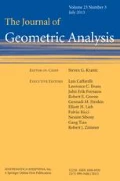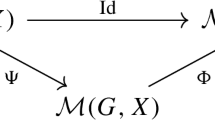Abstract
The Möbius energy is one of the knot energies, and is named after its Möbius invariant property. It is known to have several different expressions. One is in terms of the cosine of conformal angle, and is called the cosine formula. Another is the decomposition into Möbius invariant parts, called the decomposed Möbius energies. Hence the cosine formula is the sum of the decomposed energies. This raises a question. Can each of the decomposed energies be estimated by the cosine formula? Here we give an affirmative answer: the upper and lower bounds, and modulus of continuity of decomposed parts can be evaluated in terms of the cosine formula. In addition, we provide estimates of the difference in decomposed energies between the two curves in terms of Möbius invariant quantities.
Similar content being viewed by others
References
Auckly, D., Sadun, L.: A family of Möbius invariant 2-knot energies, in “Geometric Topology, Proceedings of the 1993 Georgia International Conference (University of Georgia, Athens, Georgia)”, Teil 1 (Ed.: W. H. Kazez), AMS/IP Studies in Advanced Mathematics, American Mathematical Society and International Press, Cambridge, pp. 235–258 (1997)
Blatt, S.: Boundedness and regularizing effects of O’Hara’s knot energies. J. Knot Theory Ramifications 21, 1250010 (2012)
Blatt, S.: Curves between Lipschitz and \(C^1\) and their relation to geometric knot theory. J. Geom. Anal. 29(4), 3270–3292 (2019)
Blatt, S., Reiter, Ph, Schikorra, A.: Harmonic analysis meets critical knots. Critical points of the Möbius energy are smooth. Trans. Am. Math. Soc. 368(9), 6391–6438 (2016)
Blatt, S., Reiter, Ph., Schikorra, A.: On O’Hara knot energies I: regularity for critical knots. arXiv:1905.06064
Blatt, S., Vorderobermeier, N.: On the analyticity of critical points of the Möbius energy. Calc. Var. Partial Differ. Equ. 58 (1), Paper No. 16 (2019)
Freedman, M.H., He, Z.-X., Wang, Z.: Möbius energy of knots and unknots. Ann. Math. 139(1), 1–50 (1994)
Gromov, M.: Homotopical effects of dilatation. J. Differ. Geom. 13(3), 303–310 (1978)
Gromov, M.: Filling Riemannian manifolds. J. Differ. Geom. 18(1), 1–147 (1983)
Ishizeki, A., Nagasawa, T.: A decomposition theorem of the Möbius energy I: decomposition and Möbius invariance. Kodai Math. J. 37(3), 737–754 (2014)
Ishizeki, A., Nagasawa, T.: A decomposition theorem of the Möbius energy II: variational formulae and estimates. Math. Ann. 363(1–2), 617–635 (2015)
Ishizeki, A., Nagasawa, T.: The invariance of decomposed Möbius energies under the inversions with center on curves. J. Knot Theory Ramifications 26, 1650009 (2016)
Ishizeki, A., Nagasawa, T.: The \( L^2 \)-gradient of decomposed Möbius energies. Calc. Var. Partial Differ. Equ. 55 (3), Art. No. 56 (2016)
Kusner, R., Sullivan, J. M.: On distortion and thickness of knots, in “Topology and geometry in polymer science (Minneapolis, MN, 1996)”, IMA Vol. Math. Appl. 103, Springer, New York, pp. 67–78 (1998)
Kusner, R., Sullivan, J.M.: Möbius-invariant knot energies, in “Ideal Knots”. In: Stasiak, A., Katrich, V., Kauffman, L.H. (eds.) Series on Knots and Everything, vol. 19, pp. 315–352. World Scientific, Singapore (1998)
O’Hara, J.: Energy of a knot. Topology 30(2), 241–247 (1991)
O’Hara, J.: Family of energy functionals of knots. Topol. Appl. 48(2), 147–161 (1992)
O’Hara, J.: Self-repulsiveness of energies for closed submanifolds. arXiv:2004.02351
O’Hara, J., Solanes, G.: Möbius invariant energies and average linking with circles. Tôhoku Math. J. (2) 67(1), 51–82 (2015)
O’Hara, J., Solanes, G.: Regularized Riesz energies of submanifolds. Math. Nachr. 291(8–9), 1356–1373 (2018)
Acknowledgements
The authors express their appreciation to reviewers for comments and information of related articles. In particular, [3] improves our original statement of the second assertion of Corollary 1. One of reviewers gave us a suggestion which might be useful for analyzing the open problem in Sect. 5. We are also informed of the article [18] which appeared in arXiv after our submission.
Author information
Authors and Affiliations
Corresponding author
Additional information
Publisher's Note
Springer Nature remains neutral with regard to jurisdictional claims in published maps and institutional affiliations.
A. Ishizeki: supported by KAKENHI (17J01429). T. Nagasawa: supported by KAKENHI (17K05310).
Appendix
Appendix
We derive the expression
for the conformal angle \( \varphi ( s_1 , s_2 ) \). Let \( C_{12}\) be the circle passing through two points \( \mathbf {f} (s_1)\) and \(\mathbf {f} (s_2)\) whose tangent line at \(\mathbf {f} (s_1)\) coincides with that of \(\mathrm {Im} \mathbf {f}\). And, let r and \( \mathbf{c} \) be the radius and center of \( C_{12} \), respectively. When \( \{ {\varvec{\tau }}( s_1 ) , \Delta \mathbf{f} \} \) is linearly dependent, we interpret \( C_{12} \) as the line passing through \( \mathbf{f} ( s_1 ) \) and \( \mathbf{f} ( s_2 ) \).
Case 1 \( \dim \mathrm {span} \{ {\varvec{\tau }}( s_1 ) , \Delta \mathbf{f} \} = 2 \). Since \( \Delta \mathbf{f} \) is not parallel to \( {\varvec{\tau }}( s_1 ) \) in the case,
We set
Then
and \( C_{12} \) is represented as
where \( \theta \in {\mathbb {R}} / 2 \pi {\mathbb {Z}} \) is the arc-length parameter of \( C_{12} \). Since \( \mathbf{c} = \mathbf{f} ( s_1 ) + r \mathbf{e} \),
Since \( C_{12} \) passes through \( \mathbf{f} ( s_2 ) \), there exists \( \theta _*\in {\mathbb {R}} / 2 \pi {\mathbb {Z}} \) such that \( \mathbf{x} ( \theta _*) = \mathbf{f} ( s_2 ) \). Hence
and therefore
Taking the inner product with \( \mathbf{e} \) and with \( {\varvec{\tau }}( s_1 ) \), we have
It follows from these that
Note that \( \Delta \mathbf{f} \cdot \mathbf{e} \ne 0 \) when \( \dim \mathrm {span} \{ \Delta \mathbf{f} , {\varvec{\tau }}( s_1 ) \} = 2 \). Therefore we obtain
Now we calculate the cosine of the conformal angle:
Here
Consequently, we have
Case 2 \( \dim \mathrm {span} \{ {\varvec{\tau }}( s_1 ) , \Delta \mathbf{f} \} = 1 \). In this case \( C_{12} \) can be interpreted as the line passing through \( \mathbf{f} ( s_1 ) \) and \( \mathbf{f} ( s_2 ) \). Therefore
Also we have
Hence
Rights and permissions
About this article
Cite this article
Ishizeki, A., Nagasawa, T. Upper and Lower Bounds and Modulus of Continuity of Decomposed Möbius Energies. J Geom Anal 31, 5659–5686 (2021). https://doi.org/10.1007/s12220-020-00496-x
Received:
Published:
Issue Date:
DOI: https://doi.org/10.1007/s12220-020-00496-x



